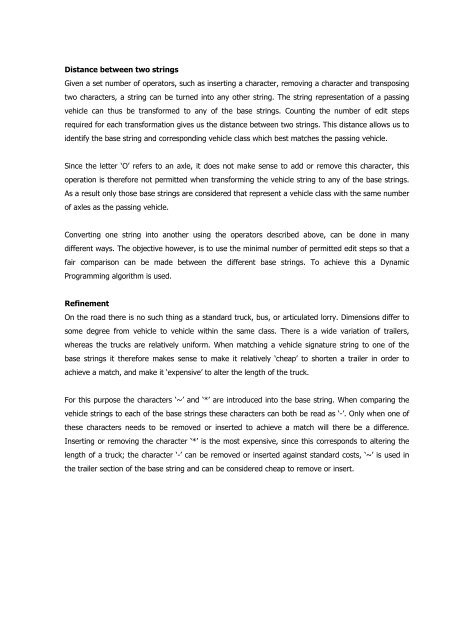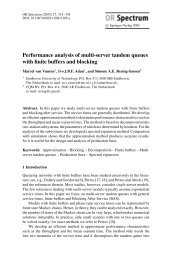Weigh-in-Motion â Categorising vehicles - Cqm
Weigh-in-Motion â Categorising vehicles - Cqm
Weigh-in-Motion â Categorising vehicles - Cqm
You also want an ePaper? Increase the reach of your titles
YUMPU automatically turns print PDFs into web optimized ePapers that Google loves.
Distance between two str<strong>in</strong>gs<br />
Given a set number of operators, such as <strong>in</strong>sert<strong>in</strong>g a character, remov<strong>in</strong>g a character and transpos<strong>in</strong>g<br />
two characters, a str<strong>in</strong>g can be turned <strong>in</strong>to any other str<strong>in</strong>g. The str<strong>in</strong>g representation of a pass<strong>in</strong>g<br />
vehicle can thus be transformed to any of the base str<strong>in</strong>gs. Count<strong>in</strong>g the number of edit steps<br />
required for each transformation gives us the distance between two str<strong>in</strong>gs. This distance allows us to<br />
identify the base str<strong>in</strong>g and correspond<strong>in</strong>g vehicle class which best matches the pass<strong>in</strong>g vehicle.<br />
S<strong>in</strong>ce the letter ‘O’ refers to an axle, it does not make sense to add or remove this character, this<br />
operation is therefore not permitted when transform<strong>in</strong>g the vehicle str<strong>in</strong>g to any of the base str<strong>in</strong>gs.<br />
As a result only those base str<strong>in</strong>gs are considered that represent a vehicle class with the same number<br />
of axles as the pass<strong>in</strong>g vehicle.<br />
Convert<strong>in</strong>g one str<strong>in</strong>g <strong>in</strong>to another us<strong>in</strong>g the operators described above, can be done <strong>in</strong> many<br />
different ways. The objective however, is to use the m<strong>in</strong>imal number of permitted edit steps so that a<br />
fair comparison can be made between the different base str<strong>in</strong>gs. To achieve this a Dynamic<br />
Programm<strong>in</strong>g algorithm is used.<br />
Ref<strong>in</strong>ement<br />
On the road there is no such th<strong>in</strong>g as a standard truck, bus, or articulated lorry. Dimensions differ to<br />
some degree from vehicle to vehicle with<strong>in</strong> the same class. There is a wide variation of trailers,<br />
whereas the trucks are relatively uniform. When match<strong>in</strong>g a vehicle signature str<strong>in</strong>g to one of the<br />
base str<strong>in</strong>gs it therefore makes sense to make it relatively ‘cheap’ to shorten a trailer <strong>in</strong> order to<br />
achieve a match, and make it ‘expensive’ to alter the length of the truck.<br />
For this purpose the characters ‘~’ and ‘*’ are <strong>in</strong>troduced <strong>in</strong>to the base str<strong>in</strong>g. When compar<strong>in</strong>g the<br />
vehicle str<strong>in</strong>gs to each of the base str<strong>in</strong>gs these characters can both be read as ‘-’. Only when one of<br />
these characters needs to be removed or <strong>in</strong>serted to achieve a match will there be a difference.<br />
Insert<strong>in</strong>g or remov<strong>in</strong>g the character ‘*’ is the most expensive, s<strong>in</strong>ce this corresponds to alter<strong>in</strong>g the<br />
length of a truck; the character ‘-’ can be removed or <strong>in</strong>serted aga<strong>in</strong>st standard costs, ‘~’ is used <strong>in</strong><br />
the trailer section of the base str<strong>in</strong>g and can be considered cheap to remove or <strong>in</strong>sert.



